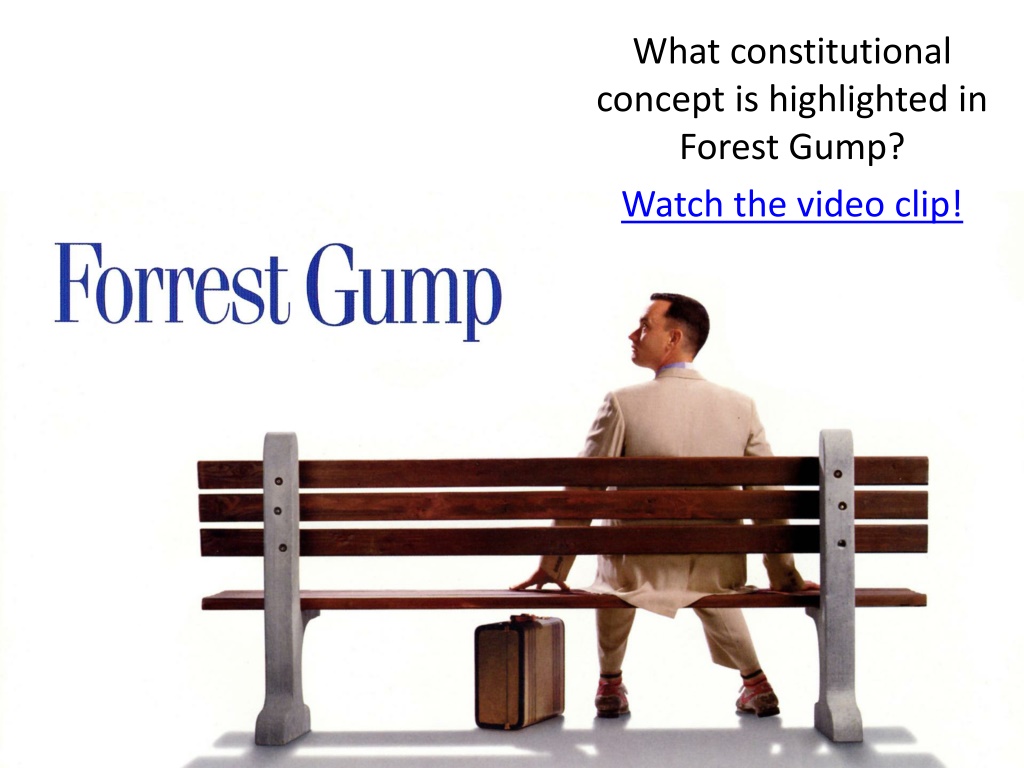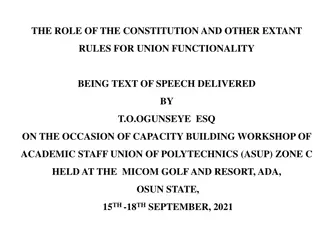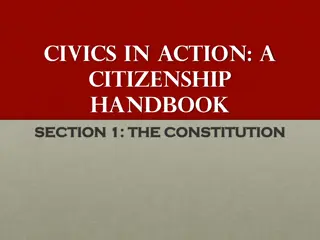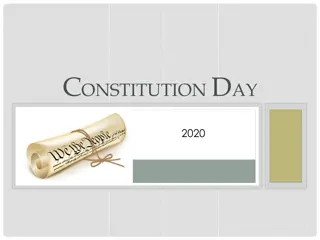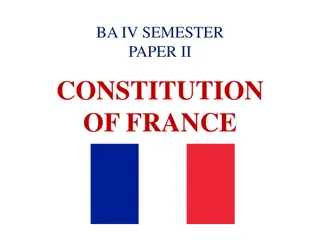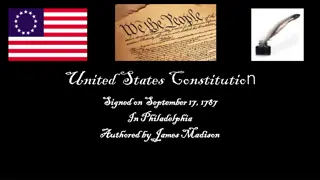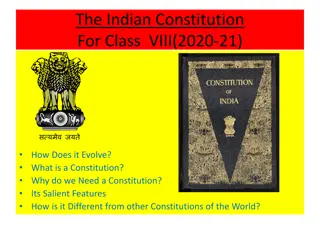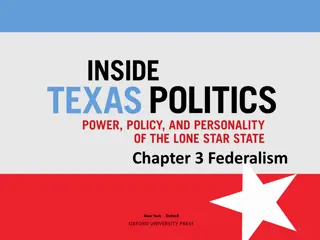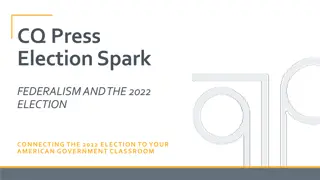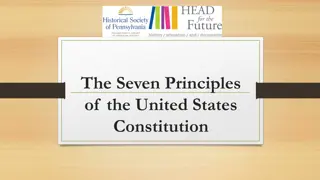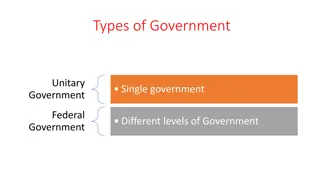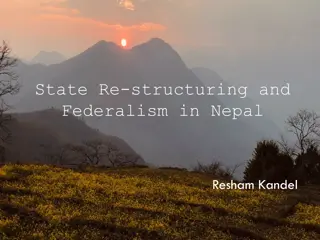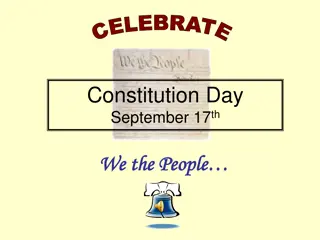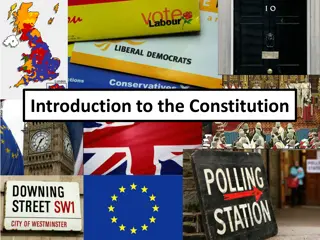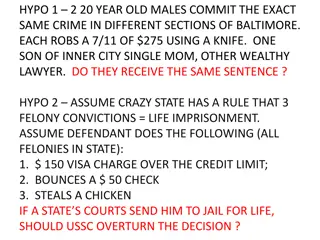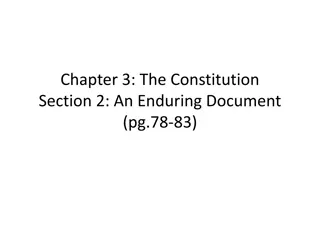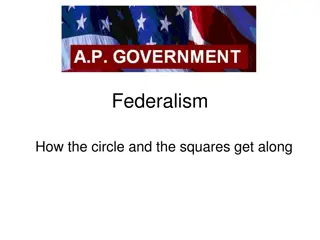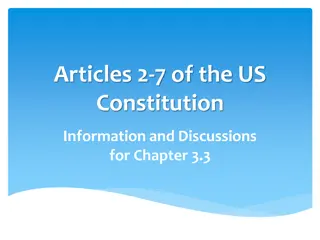Understanding Federalism in the US Constitution
Forest Gump showcases the conflict between state and federal powers, exemplified by Governor George Wallace's refusal to desegregate the University of Alabama. The scenario underscores the concept of federalism, which isn't explicitly stated in the Constitution but is evident in the division of powers between the federal and state governments. The US Constitution outlines exclusive powers of both levels of government, and examining these powers helps understand the intricate federal-state relationship.
Download Presentation

Please find below an Image/Link to download the presentation.
The content on the website is provided AS IS for your information and personal use only. It may not be sold, licensed, or shared on other websites without obtaining consent from the author. Download presentation by click this link. If you encounter any issues during the download, it is possible that the publisher has removed the file from their server.
E N D
Presentation Transcript
What constitutional concept is highlighted in Forest Gump? Watch the video clip! Governor of Alabama George Wallace refusing to desegregate the University of Alabama pursuant to federal law in 1963. The National Guard was forced to intervene and enforce federal orders. The scene exemplifies the conflict that existed between the state of Alabama and the national government.
Enquiry Question: How does the federal-state relationship work?
Learning Outcomes To understand the constitutional basis of federalism and the powers of the federal and state governments To explain the relationship between the federal government and the states To examine examples of the impact of federalism
The word federalism does not exist in the constitution, but the concept of federalism is clearly evident if you look a little closer Federalism Using a digital/print copy of the US Constitution, find evidence of the concept of federalism.
Where is federalism in the constitution? The list of powers granted to and denied to the Congress in Article I, and the powers reserved by the 10th Amendment of the U.S. Constitution serve as an outline of Federalism. YOUR TASK: Read the excerpts from the Constitution on the worksheet. Label each power; E if it represents an enumerated power (granted to the Federal government) D if it is a denied power R if it is a reserved power
Exclusive powers of the national government Print money (bills and coins) Declare war Establish an army and navy Enter into treaties with foreign governments Regulate commerce between states and international trade Establish post offices and issue postage Make laws necessary to enforce the Constitution Concurrent or shared powers Setting up courts Creating and collecting taxes Building highways Borrowing money Making and enforcing laws Chartering banks and corporations Spending money for the betterment of the general welfare Taking (condemning) private property with just compensation Exclusive powers of the state government Establish local governments Issue licenses (driver, hunting, marriage, etc.) Regulate intrastate (within the state) commerce Conduct elections Ratify amendments to the U.S. Constitution Provide for public health and safety Exercise powers neither delegated to the national government or prohibited from the states by the U.S.Constitution (For example, setting legal drinking and smoking ages.)
Where is federalism in the constitution? Discussion Questions: Which clause of Article I, Section 8 do you think has the greatest influence on the discussion of federalism? Why could the strongest case be made for this clause? The Tenth Amendment does not list any specific powers. What does that mean? In what ways might the Tenth Amendment influence the interpretation of the Enumerated Powers?
Learning Outcomes To understand the constitutional basis of federalism and the powers of the federal and state governments To explain the relationship between the federal government and the states To examine examples of the impact of federalism
Think back to Alabama and George Marshall What did the state want? What did the federal government want? Which level of government prevailed? Why? Where in the constitution is there a basis for this?
The Supremacy Clause (Article 6, Clause 2) in the Constitution establishes the Constitution and United States laws as the supreme Law of the Land. US Constitution Acts of Congress & Treaties State Constitutions However, state and local governments operate in a similar way. Read the hand-out to explain how. State statute law City Order
Sometimes only the federal government or the states legislate on an issue. However, sometimes both states and the federal legislate on the same issues. So who legislates on the following areas? Declare war on another country Decide what is discrimination and pass laws against it Decide if, when and how the death penalty is applied Decide who qualifies to vote and how voting takes place Defines marriage Defines crimes Decides the speed limit Decides if, when and who can access abortion Organises and oversees the police force
Learning Outcomes To understand the constitutional basis of federalism and the powers of the federal and state governments To explain the relationship between the federal government and the states To examine examples of the impact of federalism
Federalism in Action The balance of power and authority between the Federal government and the states has shifted at different times in American history. New legislation can grant new authority or responsibility to Federal, state, or local government. Using the worksheet, we are going to examine two famous pieces of legislation that shifted the balance of authority between the Federal government and the states during the 20th century. Each example reflects an interpretation of the relationship between state and Federal governments at one time. Balancing Federal and state powers is a complex process, and the balance of power has shifted at different times in American history.
Federalism in Action Social Security Act 1935 Voting Rights Act 1965
EXAMPLE: How does federalism affect sex? crossing a state boundary can involve stepping into another moral universe . Oral sex for example, was illegal in 15 of the 50 states as late as 1999. Adultery remained a crime in 24 of them. Eight states had prohibited the sale, though not the use of marital aids . Thirty-three states had no statute relating to fornication, but in 17 it was considered a misdemeanour or felony. Incest was a felony in 48 states but only a misdemeanour in Virginia and did not even merit a statute in Rhode Island. Prostitution was only a misdemeanour in most states but the strongest condemnatory language in American sex law was reserved for sodomy, although 23 states had no statutes at all pertaining to the practice. Theoretically the state of Alabama allows sex with donkeys and corpses (no law exists against either bestiality or necrophilia), but punishes oral sex between husbands and wives. Robert Singh, American Government & Politics p243
Learning Outcomes To understand the constitutional basis of federalism and the powers of the federal and state governments To explain the relationship between the federal government and the states To examine examples of the impact of federalism
How and why is federalism enshrined in the Constitution? Federalism is the separation of the structure of government into two more or less autonomous layers, and the powers of each are entrenched in the constitution. The term federalism is not mentioned in the constitution, but the role of the states in US government is established in the constitution principally by: equal representation of each state in the Senate the Electoral College for electing the president state boundaries cannot be changed without states consent the constitution can only be amended with the consent of of the state legislatures the tenth amendment reserves to the states all those powers not explicitly delegated to the central government The framers of the constitution wished to establish a political system which protected the role of the states, as the founders of the new country, and to create a central government strong enough to pull the country together into a functioning whole. Thus, both were granted significant powers within a federal system.
Homework Application Task: Explain how and why federalism is enshrined in the Constitution. Flipped Learning Presentation Task: Reading and Note Taking: Extent of democracy within the Constitution (Pearson p332-334) Stretch & Challenge Task The Federalist Papers
